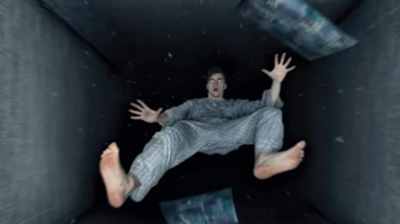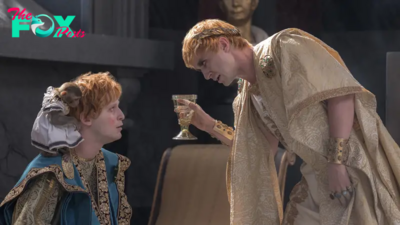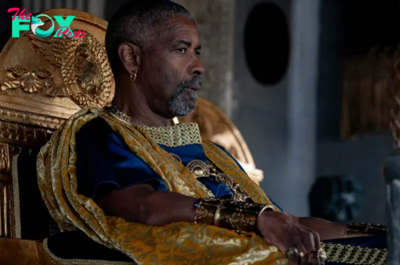Entertainment
Pablo Larraín’s Maria Strives, and Fails, to Capture the Magic of La Diva Callas
You don’t have to love opera to love Maria Callas. She was bold but vulnerable, her life roiled by drama. Her voice reflected all the colors of paradise, as it was before Adam and Eve were kicked out. And her beauty was halfway between mythical and mischievous, as if she’d been drawn by the gods’ caricaturist-in-chief: her mismatched features—the take-charge nose, the almondine eyes—met in a kind of haphazard classical perfection.
If you have room in your life for only one opera singer, Callas is the one—she’s enough. No wonder Pablo Larraín wanted to add her to his gallery of great troubled ladies, which already includes Jacqueline Kennedy Onassis (2016’s Jackie) and Princess Diana (2021’s Spencer). In Maria—playing in comPetition here at the 81st Venice Film Festival—Angelina Jolie plays La Diva Callas in the final days of her life, in 1977 Paris. Like a gothic ghost, she glides through her gilt-and-brocade apartment in fairytale dressing gowns, eating nothing but popping the sedative known as Mandrax in plentiful quantities. She has stopped performing and all but stopped singing, though she’s considering a comeback: she stands at the entrance to her kitchen and coMMAnds her loyal housekeeper Bruna (the reliably terrific Alba Rohrwacher) to listen and respond as she works her way through an aria: Bruna dutifully, and not unkindly, tells her boss what she wants to hear, even though the sound coming out of that mouth is shaky and pale, a shadow approximation of its former self. On a whim, Maria also orders her other loyal servant, Ferruccio (played by the wonderful Italian actor Pierfrancesco Favino), to move her piano from one end of the apartment to the other; in the next breath she’ll inquire about his messed-up spine. It's all in a day's work for Bruna and Ferruccio. Maria is their very own lovable, troubled tyrant.
Meanwhile, too many times to count, Jolie’s Maria gazes into the middle distance, mourning the person, the presence, the artist she used to be, reflecting aloud on her one true love, the “ugly and dead”—as she puts it—Aristotle Onassis. (When he appears in the movie's flashback scenes, a wily gnome in evening dress, he’s played by Turkish actor Haluk Bilginer.) Every gesture Jolie makes is tragic and quivering; when she smiles, it’s the wan, magnanimous kind, as if she really couldn’t be bothered. This is a performance from the “Don’t hate me because I’m beautiful” school, a great artist’s final days rendered with a self-conscious sheen that has nothing to do with the inherent grandness, or sadness, of Callas’s life.
It's not Jolie’s fault: Maria is a movie made with great respect, almost adulation, but very little that qualifies as real feeling. That’s not to say Larraín doesn’t feel for his subjects; oh, how he loves his suffering ladies! It’s just that he can’t translate those feelings into anything but tasteful, mannered kitsch. In Jackie, Natalie Portman worked valiantly to capture both her subject’s frostiness and her guarded sorrow, despite all the clever-arty filMMAking around her. And in Spencer, Kristen Stewart, one of the most original young actors we’ve got, played Princess Diana as a deeply tragic figure, which is never the same as playing a person. The movie’s most famous scene involves its lonely heroine's symbolic gobbling of a pearl necklace. The point, if the hammer hasn’t hit your head hard enough, is that poor Diana was just so hungry, for food, for love, for everything. Larraín has his loyal fans, and lovers of Jackie and Spencer may adore Maria. But to me, Larraín's allegedly sympathetic psychoportraits are the movie equivalent of Madame Alexander dolls lined up on a dresser: extremely pretty, but not made for touching.
I do acknowledge that that’s the point. These are intentionally stylized exercises, designed to come off as inventive and extreme. But their fussiness is exhausting. The plot of Maria is built around an extended visit from a TV interviewer—is he real or imagined? Does it matter?—who goes by the not-unsymbolic name of Mandrax. (He’s played by Kodi Smit-McPhee.) Dear Ferruccio, who’s trying desperately to get Maria off the pills, has told her that Mandrax—both the man and the drug—is not her friend, but to no avail. She entrusts Mandrax with her deepest secrets, including one involving her craggy, disloyal lover Onassis, who left her abruptly for that other Larraín doll-subject, Jacqueline Kennedy. Callas read about their marriage in the papers, and as Jolie’s Maria lets that truth drop, something cracks inside her—it’s the only truly moving sequence in the movie. Mostly, though, Maria is preoccupied with telling, not showing. “I am quite rebellious by nature!” Maria informs the awestruck Mandrax, as she surveys him coolly through her Nefertiti eyes. It's just one of the movie's many lines of dialogue drawn from the You Don't Say? catalog. (The screenplay is by Steven Knight, who also wrote Spencer.)
There’s much to admire in Maria, if admiration is what floats your boat. Jolie trained, with great dedication, so she could do her own singing; at times, her voice and that of Callas are melded, in various proportions, into a single track. It all sounds OK—though you might feel an instinctive shiver when the mix is heavier on Callas. The film is gorgeous to look at, thanks to ace cinematographer Ed Lachman, as well as production designer Guy Hendrix Dyas and costume designer Massimo Cantini Parrini. Jolie gets to wear some smashing ’70s-luxe togs, including several lithe tunic-and-pants ensembles and a combo dressing gown/evening coat in regal, fur-trimmed brocade. Callas had killer clothes and wore them beautifully—Maria gets that right.
Larraín doesn’t shy away from the darker corners of Callas’s life. Her mother apparently put her and her sister to work “entertaining” German and Italian soldiers during the Axis occupation of Greece; Larraín dramatizes one such episode deftly and discreetly. Yet even so, Maria captures nothing of the spirit of Callas. Jolie plays her subject as haughtily cool and deeply insecure, but captures none of her imperious charisma. Callas could be demanding, but it was all part of her sterling self-discipline: she believed in her talent above all else. And there was a great aura of joy around her, which made her vulnerability that much more piercing. Larraín does his movie no favors by using footage of the real Maria Callas in the closing credits sequence: To see her laughing just as she sang, with her whole being, or even just to catch her lost in troubled thought, is to get a jolt of all the vitality Jolie and Larraín have failed to capture. Callas, only 53 when she died, was bigger than life. Maria may burnish her legend. But it also snuffs out her spark.
-

 Entertainment2h ago
Entertainment2h agoChanges Made in New York to “Men Working” Construction Signs
-

 Entertainment5h ago
Entertainment5h agoSuggestions for delivering a POWERFUL OPENING.
-

 Entertainment5h ago
Entertainment5h agoAmerica On CoffeeWe’re simply inviting you to take a timeout into the rhythmic ambiance of our breakfast, brunch and/or espresso picks. We’re completely happy everytime you cease by.BAD DREAMS – TEDDY SWIMS
-

 Entertainment11h ago
Entertainment11h agoRemembering Song Jae-rim: A Look at His Best Movies and K-Drama Performances
-

 Entertainment21h ago
Entertainment21h agoAmerica On CoffeeWe’re simply inviting you to take a timeout into the rhythmic ambiance of our breakfast, brunch and/or espresso alternatives. We’re pleased everytime you cease by.SELF CONTROL
-

 Entertainment23h ago
Entertainment23h agoOrange County Choppers Is Ready For Its Big Comeback
-

 Entertainment1d ago
Entertainment1d agoThe Real Story of Geta and Caracalla, the Roman Brother Emperors in Gladiator II
-

 Entertainment1d ago
Entertainment1d agoWhat Gladiator II Gets Right and Wrong About Real Fights in the Colosseum

















